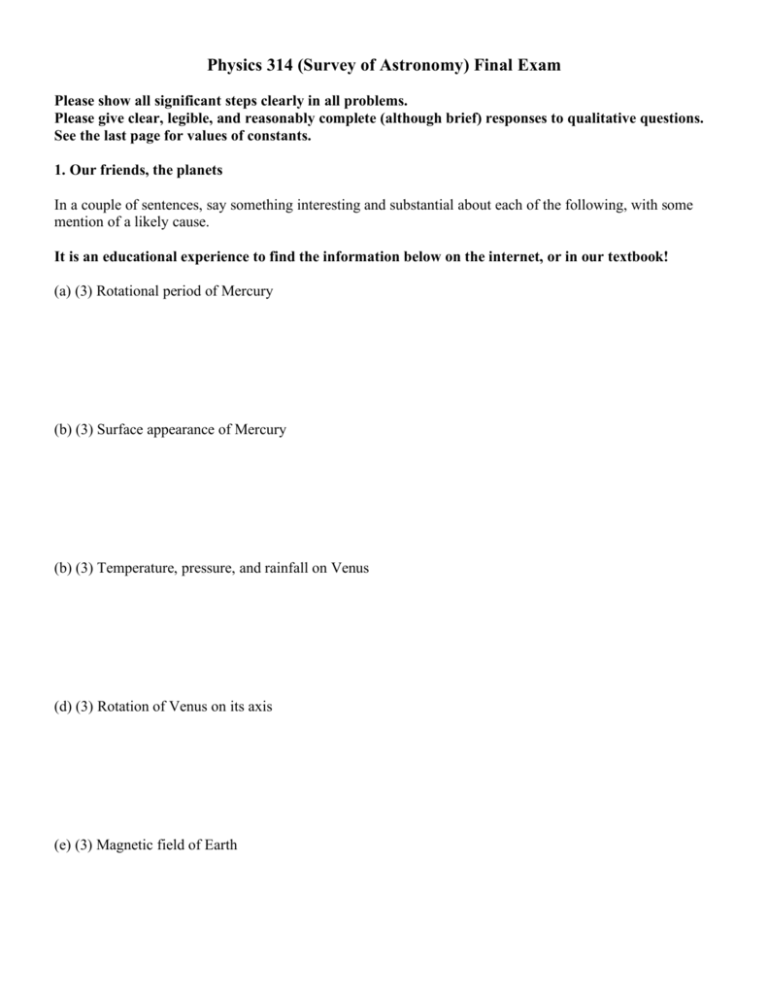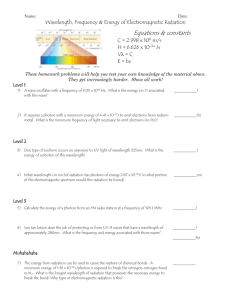Physics 314 (Survey of Astronomy) Final Exam
advertisement

Physics 314 (Survey of Astronomy) Final Exam Please show all significant steps clearly in all problems. Please give clear, legible, and reasonably complete (although brief) responses to qualitative questions. See the last page for values of constants. 1. Our friends, the planets In a couple of sentences, say something interesting and substantial about each of the following, with some mention of a likely cause. It is an educational experience to find the information below on the internet, or in our textbook! (a) (3) Rotational period of Mercury (b) (3) Surface appearance of Mercury (b) (3) Temperature, pressure, and rainfall on Venus (d) (3) Rotation of Venus on its axis (e) (3) Magnetic field of Earth (f) (3) Temperature, pressure, and surface appearance of Mars (g) (3) Vortices in atmosphere of Jupiter (h) (3) Composition of atmosphere of Saturn (i) (3) Rotation of Uranus on its axis (j) (3) Orientation of Pluto and Charon 2. How we came to have precision cosmology within the past few years What does each of these phrases mean? And what sort of information does each provide? [Please give substantial information in each case.] Again, these questions can be answered by, e.g., entering the relevant phrase at google.com – or by going to our cosmology PowerPoint presentation at http://astronomy.tamu.edu/, under “Cosmology 2005, a Tutorial”. (Please let me know if there are problems in doing this.) (a) (3) Inhomogeneities in CMB radiation (b) (3) Type Ia supernovae (c) (3) Primordial nucleosynthesis (or Big Bang nucleosynthesis) (d) (3) What are the 5 chemical species (or more precisely, isotopes) that were created in the Big Bang (as opposed to stars and supernovae)? (i) (ii) (iii) (iv) (v) 3. Nuclear decays Z=92 and A=238 for 238 U , and Z=82 and A=206 for 206 Pb . (a) (5) How many total alpha decays are required for 238 U to be transformed to 206 Pb ? Explain clearly. 8: 238-206 = 32 = 4x8, and an alpha particle has A=4 (b) (5) How many total beta decays are required for this to happen? Again, please explain clearly. 6: After 8 alpha decays alone, 16 protons would be lost, lowering the Z by 16. But we only want to lower Z by 92-82=10, so we need to have 6 neutrons converted to protons through emission of an electron and antineutrino – i.e., beta decay. 4. Motion of Galaxies Let us consider a “toy model” of the behavior of galaxies that originally led to the discovery of the dark matter. Suppose that two galaxies revolve in circular orbits about their common center of mass, and that the influence of other galaxies can be neglected. Each of the two galaxies has the same mass M . The rotational velocity is measured to be v for each galaxy. The distance between the centers of the two galaxies is measured to be 2r . (a) (3) How do we measure the velocity? [Give a little detail, in 2 or 3 sentences.] Doppler effect produces shift of spectral lines. (As for all the questions and problems, this is a skeleton version of the full answer that you should give.) (b) (3) How do we measure the distance 2r ? [Give a little detail, in 2 or3 sentences.] Measure angular separation (of centers), and establish distance from Earth with a technique like Cepheids or Tully-Fisher or Faber-Jackson, so that geometry yields distance. (c) (10) Calculate M in terms of v , r , and the gravitational constant G , starting with fundamental formulas. v2 M iM M =G r ( 2r )2 4rv 2 ! M= G (d) (5) What is the value of M in solar masses if v = 40 km/s and 2r = 1 million light years? ( )( )( )( 6 8 7 3 4rv 2 2 10 3.00 ! 10 m/s 3.16 ! 10 s 40 ! 10 m/s M= = G 6.67 ! 10 "11 N m 2 /kg 2 = 2.25 ! 1011 M ! = 225 billion solar masses ) 2 = 4.5 ! 10 41 kg M! 1.99 ! 10 30 kg 5. (12) How far away is L1? SOHO is at the L1 point. Using your knowledge of about how much larger and more massive the Sun is than the Earth, estimate how far away from the Earth the L1 point is, in kilometers. For a rough estimate, just recall that the Sun has about 100 times the diameter of the Earth, or about 10 6 times its volume, with a density which is about that of water, making the Sun very roughly a million times as massive as the Earth. However, we will use the actual numbers here, even though they were not required in doing the rough estimate for the exam. Let r be the distance from the L1 point to the Earth, and R be the distance from the Earth to the Sun, so that the distance from the L1 point to the Sun is R ! r . At the position of the Earth, the centrifugal force mv 2 / R = mR! 2 in the rotating frame of reference balances the gravitational force: M M M . M Earth R! 2 = G Sun 2 Earth " ! 2 = G Sun R R3 (Of course, we can equally well work in a nonrotating frame with no fictitious forces, and the formulas are n the same.) We will also need the approximation (1 + x ) ! 1 + nx for x ! 1 , with n = !2 and x = !r / R : !2 1 1 1 " r% 1 " 1 " r% " r %% 1 ! ' ( 2 $1 ! 2 $ ! ' ' = 2 $1 + 2 ' . 2 = 2 = 2 2 $ # R&& R # R # R& ( R ! r ) R (1 ! r / R ) R # R & At the position of L1, the Earth’s gravitational pull outward plus the centrifugal force balances the gravitational pull inward of the Sun: 1 M Earth m M m + m ( R ! r )" 2 = G Sun 2 2 r (R ! r) G # = 1 M Sun 1 (R ! r) " 2 = 2 ! 2 r M Earth ( R ! r ) GM Earth M Sun 1 ( R ! r ) G M Sun 2 ! M Earth ( R ! r ) GM Earth R3 $ M Sun 1 % r( M (R ! r) 1 + 2 * ! Sun 2 ' M Earth R & R ) M Earth R 3 = M Sun % 1 r ( M Sun % 1 r ( '& 2 + 2 3 *) ! '& 2 ! 3 *) M Earth R R M Earth R R M Sun % r ( '3 * M Earth & R 3 ) 1 3M Sun 1 # 3= r M Earth R 3 = %M ( # r = ' Earth * & 3M ) Sun 1/ 3 % 5.98 + 10 24 kg ( R=' * 30 & ( 3) 1.99 + 10 kg ) ( ) 1/ 3 ( ) = 0.01R = ( 0.01) 1.5 + 10 8 km = 1.5 million km 6. (15) Rotational states of molecules in space ° Consider an H 2 molecule, with 2 protons separated by a distance r = 0.74 A . The protons revolve around their common center of mass, with an angular momentum L . Assume L is quantized just as it is in the original Bohr theory: L = n! . 2 The kinetic energy of rotation is L / 2I , where I = 2mr 2 is the moment of inertia, and m is the mass of a proton. Calculate the wavelength of the photon emitted when the molecule falls from its n = 2 state to its n = 1 state. What part of the electromagnetic spectrum does this correspond to? L2 ( n! ) = 2I ( 2 ) 2mr 2 2 E= ( ) (1.055 ! 10 J s) = 2n = 4mr ( 4 ) (1.67 ! 10 kg ) ( 0.74 ! 10 = ( 3.04 ! 10 J ) n hf = ( 3.04 ! 10 J ) ( 2 " 1 ) = !2 "34 "27 "22 "10 m ) 2 n2 2 "22 # f= 2 2 2 2 9.12 ! 10 "22 J = 1.37 ! 1012 s-1 "34 6.63 ! 10 J s c 3.00 ! 10 8 m/s #$= = = 2.2 ! 10 "4 m = 2.2 ! 10 5 nm 12 -1 f 1.37 ! 10 s Well into the infrared, but well away from radio. 7. Van Allen Belt ! ! (a) (10) A proton has momentum p! perpendicular to the Earth’s magnetic field B and p! parallel to B . ( ) The kinetic energy p! 2 + p!2 / 2m of the proton and the “adiabatic invariant” p! 2 / B are both approximately conserved. Show that a proton traveling into a region of converging field lines near one of the ! earth’s poles must eventually reverse its direction, or “bounce” out of the region of high B . converging field lines ! large B ! large p" 2 ! small p!2 and ultimately p!2 ! 0 , so that the proton can go no further and must reverse its direction. (b) (5) Why would this effect lead to a belt of energetic charged particles in a “doughnut-shaped” structure in the Earth’s upper atmosphere? See Fig. 17.38 and surrounding text. 8. Radiation with a well-defined temperature (i.e., blackbody radiation) Planck invented quantum mechanics in 1900, and showed that it leads to an expression in agreement with experiment for the amount of radiation energy at a given wavelength ! when the temperature is T . This is called B! (T ) in the textbook. However, it may be easier to understand if we instead write the intensity in terms of the photon energy E = hf = hc / ! . Here you can assume this form, which we will call I ( E,T ) . I.e., you can assume that E3 I ( E,T ) dE = A dE , A = constant eE / kT ! 1 is the amount of radiation energy in a tiny energy interval dE at the energy E (when the temperature of the radiation is T ). Then the total amount of radiation energy is I total = ! " I ( E,T ) dE . 0 (a) (7) Show that this total amount of radiation energy is proportional to T n , where you will determine the integer n while doing this. [Hint: Get I total = T n I 0 where I 0 is an integral over a variable x that does not depend on the temperature.] I total = where # " 0 A E3 e E / kT !1 dE = A ( kT ) I 0 ! Ak 4 $ # 0 4 # " 0 ( E / kT )3 e E / kT !1 d ( E / kT ) = T 4 I 0 x3 dx , x ! E / kT ex " 1 (b) (3) It turns out that the intensity of the radiation emitted is proportional to I total . What is the law for the intensity of the radiation emitted from a blackbody at a temperature T ? Is your result in Part (a) consistent with this law? Stefan-Boltzmann law: f = ! T 4 and the above result is indeed consistent with this. (c) (7) Now approximately determine the photon energy Emax at which I ( E,T ) has its maximum as a function of E (at fixed T ). To do this, follow the usual prescription for finding the maximum of a function, by setting the derivative equal to zero. Then cleverly do some algebra to get an equation of the form E / kT = constant ! 1 - e" E / kT ( ) where you will determine the constant in doing this. Then argue that one term in the above expression can be approximately neglected, and get E / kT in the approximation that this term is neglected. This means that you have determined that Emax = some number ! kT , where Emax is the energy at which I ( E,T ) has its peak, and you will determine the value of “ some number ” while doing this. d E3 =0 " dE eE / kT ! 1 0= ( ) d 3 x x e !1 dx ( ( !1 ( Zeroth iteration: x ! 3 or Emax ! 3kT ) ) + x (e = 3 + x(1 ! e ) = 3x 2 e x ! 1 ) " 0 = 3 + x ex ! 1 " x = 3 1 ! e! x d x3 = 0 , x # E / kT dx e x ! 1 !1 ex !1 3 x ) !1 !2 ex ! x !1 (d) (3) Calculate the wavelength !max which corresponds to the energy Emax , in the sense that a photon with energy Emax has wavelength !max . What is the law which gives the peak in the function B! (T ) as a function of ! ? Is this peak wavelength the same as your !max ? If not, why not? hc / !max " 3kT # !max = ( )( ) 6.63 $ 10 %34 J & s 3.00 $ 10 8 m/s hc 0.48 cm & K = = 5kT T 3 1.38 $ 10 %23 J/K T ( ) A check with the Wien displacement law shows that the answer is different: 0.48 instead of 0.29 . The reason is that this law results from maximizing B! (T ) with respect to wavelength, so a different function is being maximized. (If you do the above treatment for B! (T ) , E 3 is essentially replaced by ! "5 , and one obtains x ! 5 or hc / "max ! 5kT , or !max = 0.29 cm " K/T .) (e) (5 points extra credit) For this much extra credit, solve the above equation more accurately for E by iterating twice with the use of a pocket calculator. This means you take the first approximation for E and insert it on the right hand side of the equation to get a better approximation for E . Then you take this second result and again insert it on the right to get a third and still better approximation. ( ) ( ) Second iteration: x = 3(1 ! e ) " 3(1 ! e ) = 2.827 Third iteration: x = 3(1 ! e ) " 3(1 ! e ) = 2.822 Fourth iteration: x = 3(1 ! e ) " 3(1 ! e ) = 2.82 or E First iteration: x = 3 1 ! e! x " 3 1 ! e!3 = 3(1 ! 0.0498 ) = 2.851 !x !x !x !2.851 !2.827 !2.822 max = 2.82 kT , which is good enough for us 9. (15) Change in temperature of radiation as the universe expands In the previous problem, you were given the function I ( E,T ) for the energy density of photons. Now let us consider the corresponding function N ( E,T ) for the number density: C E2 N ( E,T ) dE = dE , C=constant which is independent of volume V . V eE / kT ! 1 Suppose that the cosmic scale factor increases by an amount a as the universe expands: R ' = aR , where R is the value at the beginning of this period of expansion and R ' is the value at the end. Then the new volume is V ' = a3 V . Show that after the expansion, the number of photons in the tiny energy interval dE , and in the volume V , is given by C E2 N ' ( E,T ') dE = dE V eE / kT ' ! 1 where you will determine the new temperature T ' in doing this problem. The way to do this is to use the fact that the number of photons must be conserved, so that V ' N ' E ',T ' dE ' = V N ( E,T ) dE . ( ) [Hint: Define a new energy E ' also, and then at the end rename E ' to call it E .] ( ) a V N ' E ',T ' dE ' = V N ( E,T ) dE = C 3 E2 eE / kT ! 1 dE ( ) 2 2 2 C ( E / a) C ( E / a) C E' " N ' E ',T ' dE ' = d E / a = d E / a = dE ' ( ) ( ) V e( E /a ) / k (T /a ) ! 1 V e( E /a ) / k (T /a ) ! 1 V eE '/ kT ' ! 1 where E ' = E / a and T ' = T / a. ( ) C E2 dE . After renaming the integration variable E ' to call it E , we have N ' E,T ' dE = V eE / kT ' ! 1 ( )







